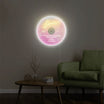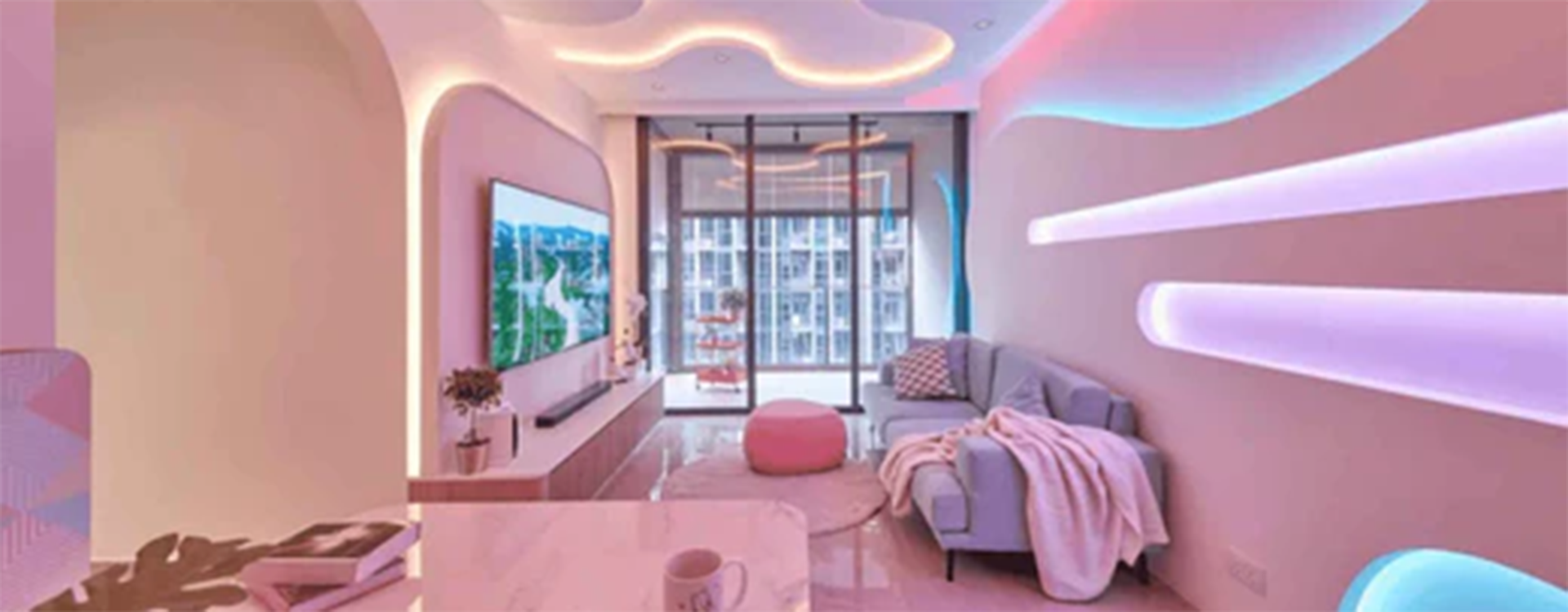College life is exciting, but let’s be real—it can also be seriously overwhelming. Between classes, exams, social obligations, and everything in between, it’s easy to feel stressed out and run down. That’s why it’s so important to have a space where you can unwind, relax, and recharge. Your dorm room can be more than just a place to crash after a long day; it can be your personal sanctuary, a retreat from the chaos of college life.
How Can Students Create a Calming and Relaxing Atmosphere in Their Dorm Rooms?
1. Use Soothing Colors:
The colors in your dorm room can have a big impact on how you feel. For a calming atmosphere, stick to soft, muted tones like pastels, light blues, greens, or neutrals. These colors are known to reduce stress and promote relaxation. For example, you can choose bedding in a light lavender or soft grey, which can help create a serene environment. If you’re into DIY, consider painting or covering your furniture in these soothing shades, or choose bedding, curtains, and rugs that align with this color palette. Even if your dorm’s rules don’t allow painting, you can still introduce calming colors through wall art, tapestries, or removable wallpaper featuring soothing patterns like waves or clouds.
2. Incorporate Soft Textures:
Soft, plush textures can make your space feel more cozy and inviting. Think fluffy throw blankets, cushy pillows, and a soft rug underfoot. For example, adding a faux fur throw blanket to your bed or a velvet cushion to your chair can instantly make your space feel more luxurious and comforting. You could also invest in a thick, shaggy rug that feels great under bare feet, turning your dorm floor into a cozy retreat. These elements not only add comfort but also create a sense of warmth and security, which is essential for relaxation. You could even create a little reading nook with a bean bag chair and a pile of pillows, perfect for decompressing after a long day.
3. Embrace Nature:
Bringing a bit of the outdoors inside can do wonders for your mental health. Houseplants, for example, are not only great for air quality but also have been shown to reduce stress and boost mood. For instance, you could place a small aloe vera plant on your windowsill, or a snake plant in the corner of your room—both of which are low-maintenance and thrive in indoor environments. If you’re not confident in your green thumb, start with something low-maintenance like succulents or a snake plant. You could also decorate with natural materials like wooden picture frames, bamboo baskets, or stone coasters to add a grounding, earthy vibe to your room. Hanging a nature-themed tapestry, like a forest or ocean scene, can also bring a calming, natural element into your space.
4. Create Ambient Lighting:
Harsh overhead lighting can be jarring and make it hard to relax. Instead, opt for ambient lighting that creates a softer, more inviting glow. String lights or fairy lights draped around your bed frame or window can add a gentle, twinkling effect that makes your room feel magical. A Himalayan salt lamp not only provides a warm, pinkish glow but is also believed to purify the air and enhance mood. A dimmable lamp is also a great option because you can adjust the brightness depending on your mood—brighter for studying, softer for winding down. For a touch of nostalgia, consider adding some Y2K-inspired lava lamps or neon signs that emit a soft, colored light, contributing to a serene ambiance. Placing a small, soft-lit lamp on your nightstand can create a perfect spot for reading or meditating before bed.
What Role Can Y2K Room Decor Neon Signs Play in Promoting Mental Wellness and Relaxation?
1. Setting the Mood for Relaxation:
Y2K-inspired neon signs are all the rage, and they can do more than just look cool—they can actually help set the mood for relaxation. The soft glow of a neon sign can create a peaceful atmosphere in your dorm room, making it easier to unwind after a long day. For example, a neon sign in calming colors like blue or pink can add a subtle, soothing light that helps you relax without overwhelming your senses. Whether it’s a simple heart, a peaceful word like “Chill,” or something more personal, a neon sign can become a comforting part of your room’s decor.
2. Personal Expression Through Decor:
Your dorm room is an extension of yourself, and decor plays a huge role in expressing your personality. Neon signs, with their retro, Y2K vibe, can be a fun and unique way to bring a bit of your own style into your space. When you feel connected to your environment, it’s easier to feel at ease and comfortable. This connection is crucial for creating a space that promotes mental wellness. Plus, neon signs can be customized to say something meaningful to you, which can serve as a daily reminder to take care of yourself.
3. Enhancing Focus and Calm:
While neon signs are often associated with fun and energy, they can also be used to enhance focus and calmness. For instance, a neon sign with a motivational phrase like “Breathe” or “Relax” can serve as a gentle reminder to slow down and take a deep breath, especially during stressful times. The steady, consistent glow of the sign can act as a visual cue to center yourself and stay grounded. It’s a small but effective way to incorporate mindfulness into your daily routine, which is essential for maintaining mental wellness in college.
What Are Effective Stress Relief Techniques for College Students Living in Dorms?
1. Practice Mindfulness and Meditation:
Mindfulness and meditation are powerful tools for managing stress, and they don’t require much space or time. Set up a small meditation corner in your dorm room with a cushion or a soft blanket, and dedicate a few minutes each day to sitting quietly and focusing on your breath. Apps like Headspace or Calm can guide you through short meditations, making it easy to integrate this practice into your routine. The best part? You can meditate right in your room, anytime you need a break from the chaos of college life.
2. Incorporate Relaxing Scents:
Aromatherapy is another great way to reduce stress and create a relaxing atmosphere in your dorm room. Essential oils like lavender, chamomile, or eucalyptus can help calm your mind and improve your mood. Use a diffuser to spread these soothing scents throughout your room, or try using a pillow spray before bed to promote better sleep. Just make sure to check your dorm’s rules about candles and diffusers—if open flames aren’t allowed, a plug-in diffuser or reed sticks are great alternatives.
3. Stay Active:
Physical activity is one of the most effective stress relievers, and it doesn’t have to be anything intense. A short walk around campus, a yoga session in your room, or even a quick dance party to your favorite playlist can do wonders for your mood. If you have the space, consider setting up a small area in your dorm for stretching or doing light exercises. Not only will this help reduce stress, but staying active also boosts endorphins, which can improve your overall mental health.
4. Create a Wind-Down Routine:
Establishing a nightly routine can signal to your body that it’s time to relax and prepare for sleep. This could include activities like reading a book, doing some light stretches, or writing in a journal. Consider dimming the lights and turning on your Y2K neon sign to create a peaceful atmosphere as you wind down. Avoid screens and stressful tasks during this time to help your mind and body transition into a restful state. A consistent wind-down routine can improve sleep quality, which is crucial for managing stress and maintaining good mental health.
How Can Dorm Room Decor Contribute to a Positive Mental Health Environment on Campus?
1. Create a Space That Reflects Positivity:
The way you decorate your dorm room can have a significant impact on your mental health. Surrounding yourself with items that bring you joy, comfort, and positivity can boost your mood and create a more uplifting environment. For example, hang up photos of loved ones, display art that makes you smile, or keep a few sentimental objects within sight. These personal touches not only make your room feel more like home but also serve as daily reminders of the positive aspects of your life.
2. Encourage a Sense of Community:
Your dorm room is part of a larger community, and fostering connections with your neighbors can contribute to your overall well-being. Consider creating a welcoming space where you and your friends can relax together. This could be as simple as having a few extra seats for visitors or keeping a stash of snacks for impromptu hangouts. By making your room a cozy and inviting space, you’re encouraging social interaction, which is essential for maintaining mental health in college.
3. Prioritize Comfort and Functionality:
While aesthetics are important, comfort and functionality should be at the forefront of your dorm room design. A comfortable chair for studying, a bed that supports good sleep, and a clutter-free environment all contribute to a space that feels good to be in. When your room is functional and comfortable, it becomes easier to relax and de-stress, making it a key component of your mental health strategy on campus.
4. Be Mindful of Sensory Overload:
College dorms can be noisy and chaotic, which can contribute to sensory overload and stress. To counteract this, create a sensory-friendly environment in your room. This might mean using sound-absorbing materials like thick curtains or rugs, playing calming music, or keeping the overall decor simple and uncluttered. By reducing sensory distractions, you can create a more peaceful and calming atmosphere that supports your mental well-being.

Conclusion
Your dorm room is more than just a place to sleep—it’s your personal retreat from the hustle and bustle of college life. By incorporating relaxing decor, like Y2K neon signs, embracing soothing colors and textures, and practicing effective stress relief techniques, you can create a space that supports your mental wellness. Remember, taking care of your mental health is just as important as your academic success. So, take the time to make your dorm room a place where you can truly relax, recharge, and thrive. Happy decorating!





















